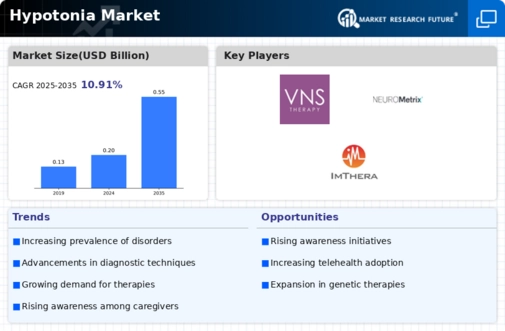Market Growth Projections
The Global Hypotonia Market Industry is projected to experience substantial growth over the next decade. With an estimated market value of 0.2 USD Billion in 2024, the industry is expected to expand significantly, reaching 0.55 USD Billion by 2035. This growth trajectory suggests a compound annual growth rate of 9.55% from 2025 to 2035, driven by various factors including increased prevalence, advancements in diagnostics, and expanded treatment options. Such projections indicate a robust future for the hypotonia market, reflecting the ongoing commitment to improving care for affected individuals.
Expansion of Treatment Options
The expansion of treatment options available for hypotonia is a significant factor driving the Global Hypotonia Market Industry. As research progresses, new therapies, including physical therapy, occupational therapy, and pharmacological interventions, are becoming more accessible. This diversification of treatment modalities allows for tailored approaches to individual patient needs, enhancing overall care. The market is expected to evolve rapidly, reflecting a growing understanding of hypotonia and its management. This evolution may also contribute to the anticipated market value of 0.55 USD Billion by 2035.
Rising Prevalence of Hypotonia
The Global Hypotonia Market Industry is experiencing growth due to the increasing prevalence of hypotonia among infants and children. Recent data indicates that hypotonia affects approximately 1 in 1,000 live births, leading to a growing demand for diagnostic and therapeutic solutions. As awareness of this condition rises, healthcare providers are more likely to identify and treat hypotonia early, contributing to market expansion. The projected market value of 0.2 USD Billion in 2024 reflects this trend, with expectations for further growth as more cases are diagnosed and treated effectively.
Advancements in Diagnostic Technologies
Technological advancements in diagnostic tools are significantly influencing the Global Hypotonia Market Industry. Innovations such as genetic testing and advanced imaging techniques enable healthcare professionals to diagnose hypotonia more accurately and swiftly. These developments not only enhance patient outcomes but also drive market demand for related services and products. As the market evolves, the integration of artificial intelligence in diagnostics could further streamline processes, potentially increasing the market value to 0.55 USD Billion by 2035. This growth is indicative of the industry's response to the need for precise and timely diagnosis.
Growing Awareness and Education Initiatives
The Global Hypotonia Market Industry benefits from growing awareness and educational initiatives aimed at both healthcare professionals and the general public. Campaigns designed to inform about the signs and symptoms of hypotonia are essential for early diagnosis and intervention. Organizations dedicated to hypotonia are actively working to disseminate information, which may lead to increased diagnosis rates and, consequently, a rise in demand for treatment options. This heightened awareness is likely to contribute to the market's growth trajectory, aligning with the projected increase in market value.
Increased Investment in Research and Development
Investment in research and development is a crucial driver for the Global Hypotonia Market Industry. Pharmaceutical companies and research institutions are increasingly focusing on developing new therapies and interventions for hypotonia. This trend is supported by government funding and grants aimed at addressing rare diseases. As a result, the market is likely to witness a compound annual growth rate of 9.55% from 2025 to 2035. This influx of investment not only fosters innovation but also enhances the availability of effective treatment options for patients suffering from hypotonia.













